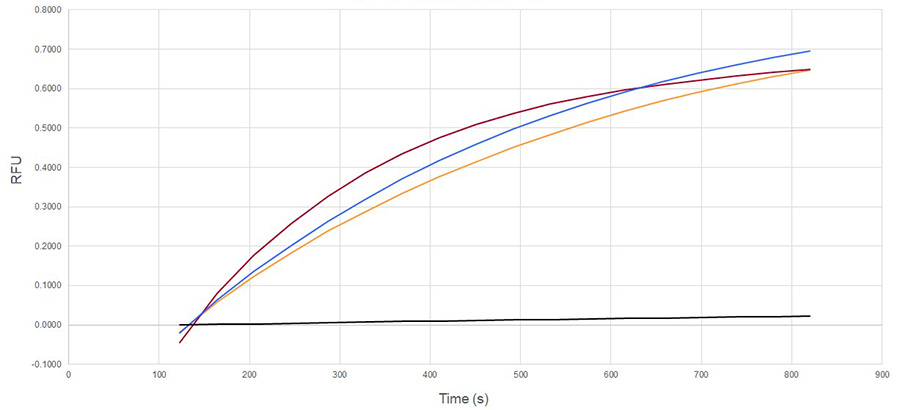Glycerol-Free RNase H (HC)
Glycerol-Free RNase H (HC) is an RNA-specific endonuclease that hydrolyzes the phosphodiester bonds of RNA, when hybridized to DNA and produces 5´ phosphate-terminated oligoribonucleotides and single-stranded DNA. It does not hydrolyze the phosphodiester bonds within single-stranded and double-stranded DNA and RNA.
Reaction Rate: RFU/s

Glycerol-Free RNase H (HC) was lyophilized at 0.2 U in 20 µL of 1x Lyo-Ready RNase H Reaction Buffer and stored in strips of 8 x 200-µL tubes. After 4 weeks, reactions stored at ambient temperature (orange line) and 37 °C (brown line) were reconstituted in 20 µL of DEPC-treated water and 5 µL of fluorescently labelled RNA-DNA hybrid was added. The rate at which fluorescence was released was compared to a wet reaction (blue line) prepared using the same concentration of Glycerol-Free RNase H (HC) and substrate (control - no RNase H added black line)).
Glycerol-Free RNase H (HC), MDX202
不含甘油的高浓度 RNA 特异性内切酶,可水解与 DNA 杂交的 RNA 的磷酸二酯键。适用于冻干。
文档与资源
Glycerol-Free RNase H (HC) is a high concentration (50 U/µL) RNA-specific endonuclease that hydrolyzes the phosphodiester bonds of RNA, when hybridized to DNA and produces 5´ phosphate-terminated oligoribonucleotides and single-stranded DNA. It does not hydrolyze the phosphodiester bonds within single-stranded and double-stranded DNA and RNA. Glycerol-Free RNase H (HC) has been optimized to deliver excellent, stable performance without glycerol, allowing you to deliver reliable results with the added capability for lyophilization. This gives you the flexibility to confidently store reaction mixtures at ambient temperature or produce diagnostic assays that rely on miniaturized reaction components.
产品资料
FAQs: Glycerol-Free RNase H (HC)
RNase H is an integral part of most RNA amplification and NASBA (nucleic acid sequence-based amplification) protocols. It can be used to degrade specific RNAs when the complementary DNA oligo is hybridized, such as poly(A) tail removal from mRNA hybridized to oligo(dT). If the RNA template is not degraded after first strand cDNA synthesis, it can bind to the newly synthesized cDNA and restrict the accessibility of primers during subsequent PCR amplification, so it can also be used for removal of RNA template after first strand cDNA synthesis for RT-PCR and RT-qPCR. RNase H is an important component in fragment analysis of capped reverse transcribed mRNA molecules, a key step in the development of an mRNA vaccine.
RNase H cleaves the RNA backbone phosphodiester bonds to leave a 3′ hydroxyl and a 5′ phosphate group.
与我们的专业团队联系
想了解更多迈迪安免疫和分子产品信息?欢迎与我们联系